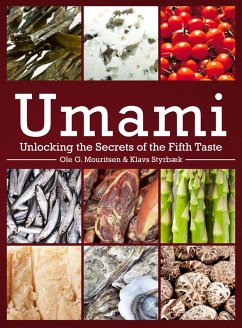Ole Mouritsen, Klavs StyrbækUnlocking the Secrets of the Fifth Taste
Umami (eBook, ePUB)
Unlocking the Secrets of the Fifth Taste
Illustrator: Drotner Mouritsen, Jonas / Übersetzer: Johansen, Mariela
22,95 €
22,95 €
inkl. MwSt.
Sofort per Download lieferbar

11 °P sammeln
22,95 €
Als Download kaufen

22,95 €
inkl. MwSt.
Sofort per Download lieferbar

11 °P sammeln
Jetzt verschenken
Alle Infos zum eBook verschenken
22,95 €
inkl. MwSt.
Sofort per Download lieferbar
Alle Infos zum eBook verschenken

11 °P sammeln
Ole Mouritsen, Klavs StyrbækUnlocking the Secrets of the Fifth Taste
Umami (eBook, ePUB)
Unlocking the Secrets of the Fifth Taste
Illustrator: Drotner Mouritsen, Jonas / Übersetzer: Johansen, Mariela
- Format: ePub
- Merkliste
- Auf die Merkliste
- Bewerten Bewerten
- Teilen
- Produkt teilen
- Produkterinnerung
- Produkterinnerung

Bitte loggen Sie sich zunächst in Ihr Kundenkonto ein oder registrieren Sie sich bei
bücher.de, um das eBook-Abo tolino select nutzen zu können.
Hier können Sie sich einloggen
Hier können Sie sich einloggen
Sie sind bereits eingeloggt. Klicken Sie auf 2. tolino select Abo, um fortzufahren.

Bitte loggen Sie sich zunächst in Ihr Kundenkonto ein oder registrieren Sie sich bei bücher.de, um das eBook-Abo tolino select nutzen zu können.
In the West, we have identified only four basic tastes-sour, sweet, salty, and bitter-that, through skillful combination and technique, create delicious foods. Yet in many parts of East Asia over the past century, an additional flavor has entered the culinary lexicon: umami, a fifth taste impression that is savory, complex, and wholly distinct.
Combining culinary history with recent research into the chemistry, preparation, nutrition, and culture of food, Mouritsen and Styrbæk encapsulate what we know to date about the concept of umami, from ancient times to today. Umami can be found in…mehr
- Geräte: eReader
- mit Kopierschutz
- eBook Hilfe
- Größe: 46.95MB
Andere Kunden interessierten sich auch für
![Adsorption: Fundamental Processes and Applications (eBook, ePUB) Adsorption: Fundamental Processes and Applications (eBook, ePUB)]() Adsorption: Fundamental Processes and Applications (eBook, ePUB)150,95 €
Adsorption: Fundamental Processes and Applications (eBook, ePUB)150,95 €![Physical Chemistry of Polymer Solutions (eBook, ePUB) Physical Chemistry of Polymer Solutions (eBook, ePUB)]() K. KamidePhysical Chemistry of Polymer Solutions (eBook, ePUB)224,95 €
K. KamidePhysical Chemistry of Polymer Solutions (eBook, ePUB)224,95 €![Atmospheric Chemistry (eBook, ePUB) Atmospheric Chemistry (eBook, ePUB)]() Ann M HollowayAtmospheric Chemistry (eBook, ePUB)30,95 €
Ann M HollowayAtmospheric Chemistry (eBook, ePUB)30,95 €![Chemistry of Functional Materials Surfaces and Interfaces (eBook, ePUB) Chemistry of Functional Materials Surfaces and Interfaces (eBook, ePUB)]() Andrei HonciucChemistry of Functional Materials Surfaces and Interfaces (eBook, ePUB)132,95 €
Andrei HonciucChemistry of Functional Materials Surfaces and Interfaces (eBook, ePUB)132,95 €![Multiphase Polylactide Blends (eBook, ePUB) Multiphase Polylactide Blends (eBook, ePUB)]() Mohammadreza NofarMultiphase Polylactide Blends (eBook, ePUB)147,95 €
Mohammadreza NofarMultiphase Polylactide Blends (eBook, ePUB)147,95 €![Zeolites in Catalysis (eBook, ePUB) Zeolites in Catalysis (eBook, ePUB)]() Zeolites in Catalysis (eBook, ePUB)232,95 €
Zeolites in Catalysis (eBook, ePUB)232,95 €![Emerging Photovoltaic Technologies (eBook, ePUB) Emerging Photovoltaic Technologies (eBook, ePUB)]() Emerging Photovoltaic Technologies (eBook, ePUB)100,95 €
Emerging Photovoltaic Technologies (eBook, ePUB)100,95 €-
-
-
In the West, we have identified only four basic tastes-sour, sweet, salty, and bitter-that, through skillful combination and technique, create delicious foods. Yet in many parts of East Asia over the past century, an additional flavor has entered the culinary lexicon: umami, a fifth taste impression that is savory, complex, and wholly distinct.
Combining culinary history with recent research into the chemistry, preparation, nutrition, and culture of food, Mouritsen and Styrbæk encapsulate what we know to date about the concept of umami, from ancient times to today. Umami can be found in soup stocks, meat dishes, air-dried ham, shellfish, aged cheeses, mushrooms, and ripe tomatoes, and it can enhance other taste substances to produce a transformative gustatory experience. Researchers have also discovered which substances in foodstuffs bring out umami, a breakthrough that allows any casual cook to prepare delicious and more nutritious meals with less fat, salt, and sugar. The implications of harnessing umami are both sensuous and social, enabling us to become more intimate with the subtleties of human taste while making better food choices for ourselves and our families.
This volume, the product of an ongoing collaboration between a chef and a scientist, won the Danish national Mad+Medier-Prisen (Food and Media Award) in the category of academic food communication.
Combining culinary history with recent research into the chemistry, preparation, nutrition, and culture of food, Mouritsen and Styrbæk encapsulate what we know to date about the concept of umami, from ancient times to today. Umami can be found in soup stocks, meat dishes, air-dried ham, shellfish, aged cheeses, mushrooms, and ripe tomatoes, and it can enhance other taste substances to produce a transformative gustatory experience. Researchers have also discovered which substances in foodstuffs bring out umami, a breakthrough that allows any casual cook to prepare delicious and more nutritious meals with less fat, salt, and sugar. The implications of harnessing umami are both sensuous and social, enabling us to become more intimate with the subtleties of human taste while making better food choices for ourselves and our families.
This volume, the product of an ongoing collaboration between a chef and a scientist, won the Danish national Mad+Medier-Prisen (Food and Media Award) in the category of academic food communication.
Dieser Download kann aus rechtlichen Gründen nur mit Rechnungsadresse in A, D ausgeliefert werden.
Produktdetails
- Produktdetails
- Verlag: Columbia University Press
- Erscheinungstermin: 3. Juni 2014
- Englisch
- ISBN-13: 9780231537582
- Artikelnr.: 40775878
- Verlag: Columbia University Press
- Erscheinungstermin: 3. Juni 2014
- Englisch
- ISBN-13: 9780231537582
- Artikelnr.: 40775878
- Herstellerkennzeichnung Die Herstellerinformationen sind derzeit nicht verfügbar.
Ole G. Mouritsen is a distinguished scientist and professor of biophysics at the University of Southern Denmark. His books include Sushi: Food for the Eye, the Body, and the Soul and Seaweeds: Edible, Available, and Sustainable.
Klavs Styrbæk is a chef who, for more than twenty years, has owned and run the highly regarded Restaurant Kvægtorvet (The Cattle Market) in Odense, Denmark. He is a passionate advocate for the renewal of classical Danish cuisine.
Mariela Johansen has Danish roots, lives in Canada, and holds an MA in humanities.
Jonas Drotner Mouritsen is a graphic designer and owns the design company Chromascope (www.chromascope.com). His movie projects have won several international awards.
Klavs Styrbæk is a chef who, for more than twenty years, has owned and run the highly regarded Restaurant Kvægtorvet (The Cattle Market) in Odense, Denmark. He is a passionate advocate for the renewal of classical Danish cuisine.
Mariela Johansen has Danish roots, lives in Canada, and holds an MA in humanities.
Jonas Drotner Mouritsen is a graphic designer and owns the design company Chromascope (www.chromascope.com). His movie projects have won several international awards.
Acknowledgments Prologue: How it all began What exactly is taste, and why is it important? The basic tastes: From seven to four to five and possibly many more Why do we need to be able to taste our food? There is more to it: Sensory science, taste, smell, aroma, flavor, mouthfeel, texture, and chemesthesis Is there a taste map of the tongue? Why are some foods more palatable than others? A few words about proteins, amino acids, nucleotides, nucleic acids, and enzymes Glutamic acid, glutamate, and the glutamate ion Glutamic acid and glutamate in our food How does glutamate taste, and how little is required for us to taste it? The first four: Sour, sweet, salty, and bitter The physiology and biochemistry of taste The interplay between sweet and bitter Taste receptors: This is how they work When words fail us: Descriptions of tastes The fifth taste: What is umami? Science, soup, and the search for the fifth taste Glutamic acid and glutamate What is the meaning of the word umami? From laboratory to mass production How MSG is made A little letter with a huge impact: The 'Chinese restaurant syndrome' The Japanese discover other umami substances It all starts with mother's milk Umami as a global presence Umami has won acceptance as a distinct taste And umami is still controversial 1 + 1 = 8: Gustatory synergy Amazing interplay: Basal and synergistic umami Detecting umami synergy on the tongue and in the brain Japanese dashi: The textbook example of umami synergy The art of making Japanese dashi Nordic dashi Dashi closer to home—a Japanese soup with a Scandinavian twist Seaweeds enhance the umami in fish How to make smoked shrimp heads Many substances interact synergistically with umami A breakthrough discovery of yet another synergistic substance The interplay between glutamate and the four classic tastes A simple taste test: Umami vs. salt Umami-rich 'foie gras from the sea' Food pairing and umami Creating tastes synthetically Umami: Either as little or as much as you like Umami from the oceans: Seaweeds, fish, and shellfish Seaweeds and konbu: The mother lode of umami A world of konbu in Japan Fresh fish and shellfish Cooked fish and shellfish dishes and soups Umami and the art of killing a fish A traditional clambake: New England method, Danish ingredients Everyday umami in ancient Greece and Rome Fish sauces and fish pastes Modern garum Shellfish paste Oyster sauce Sushi and fermented fish Katsuobushi Catching katsuo to optimize umami Niboshi The hardest foodstuff in the world Kusaya Nordic variations: Horrible smells and heavenly tastes Fish roe Seven friends, The Compleat Angler, and a pike Umami from the land: Fungi and plants Umami from the plant kingdom Dried fungi Fermented soybeans Soy sauce Production of sh
yu Miso Production of miso The Asian answer to cheese: Fermented soybean cakes Natt
Black garlic Sh
jin ry
ri: An old tradition with a modern presence The enlightened kitchen Tomatoes Green tea Umami from land animals: Meat, eggs, and dairy products The animal kingdom delivers umami in spades Homo sapiens is a cook Preserving meats in the traditional ways Air-dried hams Salted beef: Pastrami and corned beef Bacon and sausages Dairy products Blue cheeses Aged, dried, and hard cheeses Eggs and mayonnaise Harry's crème from Harry's Bar Umami: The secret behind the humble soup stock Soup is umami Osmazome and The Physiology of Taste Amino acids in soup stocks A real find: A dashi bar The taste of a beef stock Ready-made umami Knorr and Maggi: European umami pioneers Making the most of umami MSG as a food additive Other commercial sources of umami Hydrolyzed protein Umami in a jar Yeast extract Nutritional yeast More sources of umami for vegans Ketchup Bagna càuda Worcestershire sauce Umami in a tube Twelve easy ways to add umami Quintessentially Danish: Brown gravy, medisterpølse, and beef patties Slow cooking: The secret of more umami Ratatouille and brandade This is why fast food tastes so good Green salads and raw vegetables Umami in dishes made with small fowl Cooked potatoes: Nothing could be simpler Rice and sake Beer Umami in sweets Mirin is a sweet rice wine with umami Umami and wellness Umami and MSG: Food without 'chemicals' Umami satisfies the appetite Why does umami make us feel full? The 'brain' in the stomach Umami for a sick and aging population Umami for life Epilogue: Umami has come to stay Technical and scientific details Umami and the first glutamate receptor Yet another receptor for umami Umami synergy The taste of amino acids Taste thresholds for umami Content of glutamate and 5'-ribonucleotides in different foods Bibliography Illustration credits Glossary Index The people behind the book Recipes Potato water dashi with smoked shrimp heads Monkfish liver au gratin with crabmeat and vegetables Pearled spelt, beets, and lobster Crab soup Clambake in a pot Patina de pisciculis Garum Quick-and-easy garum Smoked quick-and-easy garum Seriously old-fashioned sourdough rye bread Anchovies, grilled onions, sourdough bread, pata negra ham, and mushrooms Deep-fried eggplants with miso (nasu dengaku) White asparagus in miso with oysters, cucumber oil, and small fish Grilled sh
jin kabayaki: 'fried eel' made from lotus root Baked monkfish liver with raspberries and peanuts Slow-roasted sauce with tomatoes, root vegetables, and herbs Fried mullet with baked grape tomatoes, marinated sago pearls, and black garlic Mushrooms, foie gras, and mushroom essence Parmesan biscuits with bacon and yeast flakes Harry's crème Chicken bouillon Green pea soup with scallops and seaweed Dressing with nutritional yeast Eggplant gratinée with garlic, anchovies, and nutritional yeast Oysters au gratin with a crust of nutritional yeast and smoked shrimp head powder Bagna càuda Old-fashioned Danish medisterpølse Beef patties, Danish style Chicken Marengo Cassoulet Beef estofado Sicilian ratatouille Brandade with air-dried ham and green peas Three-day pizza with umami—not really a 'fast food' Quail pâté Risotto Oxtails braised in wheat beer Umami sorbet with maccha and tomato White chocolate cream, black sesame seeds, Roquefort, and brioche with nutritional yeast
yu Miso Production of miso The Asian answer to cheese: Fermented soybean cakes Natt
Black garlic Sh
jin ry
ri: An old tradition with a modern presence The enlightened kitchen Tomatoes Green tea Umami from land animals: Meat, eggs, and dairy products The animal kingdom delivers umami in spades Homo sapiens is a cook Preserving meats in the traditional ways Air-dried hams Salted beef: Pastrami and corned beef Bacon and sausages Dairy products Blue cheeses Aged, dried, and hard cheeses Eggs and mayonnaise Harry's crème from Harry's Bar Umami: The secret behind the humble soup stock Soup is umami Osmazome and The Physiology of Taste Amino acids in soup stocks A real find: A dashi bar The taste of a beef stock Ready-made umami Knorr and Maggi: European umami pioneers Making the most of umami MSG as a food additive Other commercial sources of umami Hydrolyzed protein Umami in a jar Yeast extract Nutritional yeast More sources of umami for vegans Ketchup Bagna càuda Worcestershire sauce Umami in a tube Twelve easy ways to add umami Quintessentially Danish: Brown gravy, medisterpølse, and beef patties Slow cooking: The secret of more umami Ratatouille and brandade This is why fast food tastes so good Green salads and raw vegetables Umami in dishes made with small fowl Cooked potatoes: Nothing could be simpler Rice and sake Beer Umami in sweets Mirin is a sweet rice wine with umami Umami and wellness Umami and MSG: Food without 'chemicals' Umami satisfies the appetite Why does umami make us feel full? The 'brain' in the stomach Umami for a sick and aging population Umami for life Epilogue: Umami has come to stay Technical and scientific details Umami and the first glutamate receptor Yet another receptor for umami Umami synergy The taste of amino acids Taste thresholds for umami Content of glutamate and 5'-ribonucleotides in different foods Bibliography Illustration credits Glossary Index The people behind the book Recipes Potato water dashi with smoked shrimp heads Monkfish liver au gratin with crabmeat and vegetables Pearled spelt, beets, and lobster Crab soup Clambake in a pot Patina de pisciculis Garum Quick-and-easy garum Smoked quick-and-easy garum Seriously old-fashioned sourdough rye bread Anchovies, grilled onions, sourdough bread, pata negra ham, and mushrooms Deep-fried eggplants with miso (nasu dengaku) White asparagus in miso with oysters, cucumber oil, and small fish Grilled sh
jin kabayaki: 'fried eel' made from lotus root Baked monkfish liver with raspberries and peanuts Slow-roasted sauce with tomatoes, root vegetables, and herbs Fried mullet with baked grape tomatoes, marinated sago pearls, and black garlic Mushrooms, foie gras, and mushroom essence Parmesan biscuits with bacon and yeast flakes Harry's crème Chicken bouillon Green pea soup with scallops and seaweed Dressing with nutritional yeast Eggplant gratinée with garlic, anchovies, and nutritional yeast Oysters au gratin with a crust of nutritional yeast and smoked shrimp head powder Bagna càuda Old-fashioned Danish medisterpølse Beef patties, Danish style Chicken Marengo Cassoulet Beef estofado Sicilian ratatouille Brandade with air-dried ham and green peas Three-day pizza with umami—not really a 'fast food' Quail pâté Risotto Oxtails braised in wheat beer Umami sorbet with maccha and tomato White chocolate cream, black sesame seeds, Roquefort, and brioche with nutritional yeast
Acknowledgments Prologue: How it all began What exactly is taste, and why is it important? The basic tastes: From seven to four to five and possibly many more Why do we need to be able to taste our food? There is more to it: Sensory science, taste, smell, aroma, flavor, mouthfeel, texture, and chemesthesis Is there a taste map of the tongue? Why are some foods more palatable than others? A few words about proteins, amino acids, nucleotides, nucleic acids, and enzymes Glutamic acid, glutamate, and the glutamate ion Glutamic acid and glutamate in our food How does glutamate taste, and how little is required for us to taste it? The first four: Sour, sweet, salty, and bitter The physiology and biochemistry of taste The interplay between sweet and bitter Taste receptors: This is how they work When words fail us: Descriptions of tastes The fifth taste: What is umami? Science, soup, and the search for the fifth taste Glutamic acid and glutamate What is the meaning of the word umami? From laboratory to mass production How MSG is made A little letter with a huge impact: The 'Chinese restaurant syndrome' The Japanese discover other umami substances It all starts with mother's milk Umami as a global presence Umami has won acceptance as a distinct taste And umami is still controversial 1 + 1 = 8: Gustatory synergy Amazing interplay: Basal and synergistic umami Detecting umami synergy on the tongue and in the brain Japanese dashi: The textbook example of umami synergy The art of making Japanese dashi Nordic dashi Dashi closer to home—a Japanese soup with a Scandinavian twist Seaweeds enhance the umami in fish How to make smoked shrimp heads Many substances interact synergistically with umami A breakthrough discovery of yet another synergistic substance The interplay between glutamate and the four classic tastes A simple taste test: Umami vs. salt Umami-rich 'foie gras from the sea' Food pairing and umami Creating tastes synthetically Umami: Either as little or as much as you like Umami from the oceans: Seaweeds, fish, and shellfish Seaweeds and konbu: The mother lode of umami A world of konbu in Japan Fresh fish and shellfish Cooked fish and shellfish dishes and soups Umami and the art of killing a fish A traditional clambake: New England method, Danish ingredients Everyday umami in ancient Greece and Rome Fish sauces and fish pastes Modern garum Shellfish paste Oyster sauce Sushi and fermented fish Katsuobushi Catching katsuo to optimize umami Niboshi The hardest foodstuff in the world Kusaya Nordic variations: Horrible smells and heavenly tastes Fish roe Seven friends, The Compleat Angler, and a pike Umami from the land: Fungi and plants Umami from the plant kingdom Dried fungi Fermented soybeans Soy sauce Production of sh
yu Miso Production of miso The Asian answer to cheese: Fermented soybean cakes Natt
Black garlic Sh
jin ry
ri: An old tradition with a modern presence The enlightened kitchen Tomatoes Green tea Umami from land animals: Meat, eggs, and dairy products The animal kingdom delivers umami in spades Homo sapiens is a cook Preserving meats in the traditional ways Air-dried hams Salted beef: Pastrami and corned beef Bacon and sausages Dairy products Blue cheeses Aged, dried, and hard cheeses Eggs and mayonnaise Harry's crème from Harry's Bar Umami: The secret behind the humble soup stock Soup is umami Osmazome and The Physiology of Taste Amino acids in soup stocks A real find: A dashi bar The taste of a beef stock Ready-made umami Knorr and Maggi: European umami pioneers Making the most of umami MSG as a food additive Other commercial sources of umami Hydrolyzed protein Umami in a jar Yeast extract Nutritional yeast More sources of umami for vegans Ketchup Bagna càuda Worcestershire sauce Umami in a tube Twelve easy ways to add umami Quintessentially Danish: Brown gravy, medisterpølse, and beef patties Slow cooking: The secret of more umami Ratatouille and brandade This is why fast food tastes so good Green salads and raw vegetables Umami in dishes made with small fowl Cooked potatoes: Nothing could be simpler Rice and sake Beer Umami in sweets Mirin is a sweet rice wine with umami Umami and wellness Umami and MSG: Food without 'chemicals' Umami satisfies the appetite Why does umami make us feel full? The 'brain' in the stomach Umami for a sick and aging population Umami for life Epilogue: Umami has come to stay Technical and scientific details Umami and the first glutamate receptor Yet another receptor for umami Umami synergy The taste of amino acids Taste thresholds for umami Content of glutamate and 5'-ribonucleotides in different foods Bibliography Illustration credits Glossary Index The people behind the book Recipes Potato water dashi with smoked shrimp heads Monkfish liver au gratin with crabmeat and vegetables Pearled spelt, beets, and lobster Crab soup Clambake in a pot Patina de pisciculis Garum Quick-and-easy garum Smoked quick-and-easy garum Seriously old-fashioned sourdough rye bread Anchovies, grilled onions, sourdough bread, pata negra ham, and mushrooms Deep-fried eggplants with miso (nasu dengaku) White asparagus in miso with oysters, cucumber oil, and small fish Grilled sh
jin kabayaki: 'fried eel' made from lotus root Baked monkfish liver with raspberries and peanuts Slow-roasted sauce with tomatoes, root vegetables, and herbs Fried mullet with baked grape tomatoes, marinated sago pearls, and black garlic Mushrooms, foie gras, and mushroom essence Parmesan biscuits with bacon and yeast flakes Harry's crème Chicken bouillon Green pea soup with scallops and seaweed Dressing with nutritional yeast Eggplant gratinée with garlic, anchovies, and nutritional yeast Oysters au gratin with a crust of nutritional yeast and smoked shrimp head powder Bagna càuda Old-fashioned Danish medisterpølse Beef patties, Danish style Chicken Marengo Cassoulet Beef estofado Sicilian ratatouille Brandade with air-dried ham and green peas Three-day pizza with umami—not really a 'fast food' Quail pâté Risotto Oxtails braised in wheat beer Umami sorbet with maccha and tomato White chocolate cream, black sesame seeds, Roquefort, and brioche with nutritional yeast
yu Miso Production of miso The Asian answer to cheese: Fermented soybean cakes Natt
Black garlic Sh
jin ry
ri: An old tradition with a modern presence The enlightened kitchen Tomatoes Green tea Umami from land animals: Meat, eggs, and dairy products The animal kingdom delivers umami in spades Homo sapiens is a cook Preserving meats in the traditional ways Air-dried hams Salted beef: Pastrami and corned beef Bacon and sausages Dairy products Blue cheeses Aged, dried, and hard cheeses Eggs and mayonnaise Harry's crème from Harry's Bar Umami: The secret behind the humble soup stock Soup is umami Osmazome and The Physiology of Taste Amino acids in soup stocks A real find: A dashi bar The taste of a beef stock Ready-made umami Knorr and Maggi: European umami pioneers Making the most of umami MSG as a food additive Other commercial sources of umami Hydrolyzed protein Umami in a jar Yeast extract Nutritional yeast More sources of umami for vegans Ketchup Bagna càuda Worcestershire sauce Umami in a tube Twelve easy ways to add umami Quintessentially Danish: Brown gravy, medisterpølse, and beef patties Slow cooking: The secret of more umami Ratatouille and brandade This is why fast food tastes so good Green salads and raw vegetables Umami in dishes made with small fowl Cooked potatoes: Nothing could be simpler Rice and sake Beer Umami in sweets Mirin is a sweet rice wine with umami Umami and wellness Umami and MSG: Food without 'chemicals' Umami satisfies the appetite Why does umami make us feel full? The 'brain' in the stomach Umami for a sick and aging population Umami for life Epilogue: Umami has come to stay Technical and scientific details Umami and the first glutamate receptor Yet another receptor for umami Umami synergy The taste of amino acids Taste thresholds for umami Content of glutamate and 5'-ribonucleotides in different foods Bibliography Illustration credits Glossary Index The people behind the book Recipes Potato water dashi with smoked shrimp heads Monkfish liver au gratin with crabmeat and vegetables Pearled spelt, beets, and lobster Crab soup Clambake in a pot Patina de pisciculis Garum Quick-and-easy garum Smoked quick-and-easy garum Seriously old-fashioned sourdough rye bread Anchovies, grilled onions, sourdough bread, pata negra ham, and mushrooms Deep-fried eggplants with miso (nasu dengaku) White asparagus in miso with oysters, cucumber oil, and small fish Grilled sh
jin kabayaki: 'fried eel' made from lotus root Baked monkfish liver with raspberries and peanuts Slow-roasted sauce with tomatoes, root vegetables, and herbs Fried mullet with baked grape tomatoes, marinated sago pearls, and black garlic Mushrooms, foie gras, and mushroom essence Parmesan biscuits with bacon and yeast flakes Harry's crème Chicken bouillon Green pea soup with scallops and seaweed Dressing with nutritional yeast Eggplant gratinée with garlic, anchovies, and nutritional yeast Oysters au gratin with a crust of nutritional yeast and smoked shrimp head powder Bagna càuda Old-fashioned Danish medisterpølse Beef patties, Danish style Chicken Marengo Cassoulet Beef estofado Sicilian ratatouille Brandade with air-dried ham and green peas Three-day pizza with umami—not really a 'fast food' Quail pâté Risotto Oxtails braised in wheat beer Umami sorbet with maccha and tomato White chocolate cream, black sesame seeds, Roquefort, and brioche with nutritional yeast







